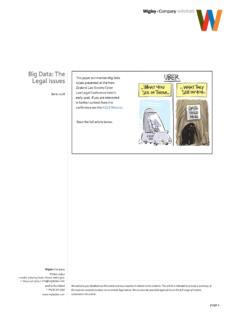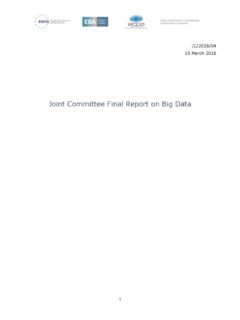Transcription of Implications of Big Data for Customs - How It Can Support ...
1 WCO Research Paper No. 39 Implications of big data for Customs - How It Can Support Risk Management Capabilities (March 2017) Yotaro Okazaki 2 Abstract The purpose of this paper is to discuss the Implications of big data for Customs , particularly in terms of risk management. To ensure that better informed and smarter decisions are taken, some Customs administrations have already embarked on big data initiatives, leveraging the power of analytics, ensuring the quality of data (regarding cargos, shipments and conveyances), and widening the scope of data they could use for analytical purposes. This paper illustrates these initiatives based on the information shared by five Customs administrations: Canada Border Services Agency (CBSA); Customs and Excise Department, Hong Kong, China ( Hong Kong China Customs ); New Zealand Customs Service ( New Zealand Customs ); Her Majesty s Revenue and Customs (HMRC), the United Kingdom; and Customs and Border Protection (USCBP).
2 Key words Customs , big data , Risk Management, Analytics Acknowledgements This paper was written by Yotaro Okazaki of the WCO s Research Unit. Disclaimer The WCO Research Paper Series disseminates the findings of work in progress to encourage the exchange of ideas about Customs issues. The views and opinions presented in this paper are those of the author and do not necessarily reflect the views or policies of the WCO or WCO Members. Note All WCO Research Papers are available on the WCO public website: The author may be contacted via ----------------------- Copyright 2017 World Customs Organization. All rights reserved. Requests and enquiries concerning translation, reproduction and adaptation rights should be addressed to 3 I.
3 Introduction The term big data embraces a broad category of data or datasets that, in order to be fully exploited, require advanced technologies to be used in parallel. Many big data applications have the potential to optimize organizations performance, including the optimal allocation of human or financial resources in a manner that maximizes outputs. Nowadays businesses deal with a large amount of data collected through interactions with current or potential customers, in an effort to raise their operational efficiency and expand the market frontier. With respect to e-commerce, online retailers have continually updated and analysed the data concerning consumers behaviour, trying to uncover latent consumption propensity the information used to figure out what they should merchandise and how.
4 Armed with these data , they have been able to assess risks in terms of consumer credit to minimize their potential loss in revenue. Widespread use of communication devices has significantly boosted the volume of transactions involving online sale of consumer goods, while simultaneously boosting the frequency and volume of B to C data transmissions. With the prevalence of electronic devices connected to the Internet ( smartphones, tablets, smart TVs, wearables, and in-vehicle infotainment devices), big data exists almost everywhere today. Social media generates huge data every second, the only way to arrest this traffic would be if the countless users stopped delivering, sharing or posting everything from text messages to recorded videos over the Internet at once.
5 The Internet of Things technology has incorporated many kinds of physical goods ( home appliances, security cameras and garbage containers) into the big data applications. Where trade in goods is concerned, stakeholders such as manufactures, shippers and logistics operators have focused on ensuring that the vast array of data raging from personal transaction history to the location of containerized goods can be put to practical use, with a view to providing quality service and enhancing the connectivity to be reflected in the supply chain. The purpose of this paper is to discuss the Implications of the aforementioned big data for Customs , particularly in terms of risk management. To ensure that better informed and smarter decisions are taken, some Customs administrations have already embarked on big data initiatives, leveraging the power of analytics, ensuring the quality of data (regarding cargos, shipments and conveyances), and widening the scope of data they could use for analytical purposes.
6 This paper illustrates these initiatives based on the information shared by five Customs administrations: Canada Border Services Agency (CBSA); Customs and Excise Department, Hong Kong, China ( Hong Kong China Customs ); New Zealand Customs Service ( New Zealand Customs ); Her Majesty s Revenue and Customs (HMRC), the United Kingdom; and Customs and Border Protection (USCBP). 4 II. Understanding big data big data entails huge datasets which are considered too big to complete the necessary work within an acceptable waiting time by relying on traditional data management and processing models. Although such a description is often associated with the concept, there is no single agreed definition of big data 1. It is, however, interesting to note that the term was characterized by Gartner2 as high-volume, high-velocity and/or high-variety information assets that demand cost-effective, innovative forms of information processing that enable enhanced insight, decision making, and process automation.
7 3 This explains in a concise manner several data -specific features, often referred to as the 3-Vs of big data : volume, velocity, and variety. Volume usually denotes the size and scale of individual datasets, while often referring to the aggregate amount of data on earth. One study demonstrated that in 2012, approximately zettabytes (ZB) of data were created and replicated, projecting the volume to reach 44 ZB by 20204. Velocity is considered to include both speed and frequency with which data can be created, updated and processed. Variety is somewhat synonymous with diversity in that data can be diverse in format, semantics, origin and medium. Indeed, big data can be obtained from a wide variety of sources, and it is said that at least eighty percent of corporate (or business-relevant) data are unstructured5.
8 Box 1. The 3-Vs of big data Volume From 2005 to 2020, the digital universe will grow by a factor of 300, from 130 exabytes (EB) to 40,000 EB, or 40 trillion gigabytes (more than 5,200 gigabytes for every man, woman and child in 2020). Until 2020, the digital universe will about double every two years6. International System of Units (SI) International Electrotechnical Commission (IEC)-approved prefixes for binary multiples (for data processing and data transmission) kilo k 103 kibi Ki 210 = 1 024 mega M 106 mebi Mi 220 = 1 048 576 giga G 109 gibi Gi 230 = 1 073 741 824 tera T 1012 tebi Ti 240 = 1 099 511 627 776 peta P 1015 peti Pi 250 = 1 125 899 906 842 624 exa E 1018 exbi Ei 260 = 1 152 921 504 606 846 976 zetta Z 1021 zebi Zi 270 = 1 180 591 620 717 411 303 424 yotta Y 1024 yobi Yi 280 = 1 208 925 819 614 629 174 706 176 1 Cleary (2017).
9 2 An IT-related marketing company headquartered in Stamford, Connecticut, the United States. 3 Gartner I T Glossary , (last visited 7 March, 2017). 4 EMC Press Release, (last visited 7 March, 2017). 5 Id. 6 EMC (2012). 5 A major factor behind the expansion of the digital universe is the growth of machine- generated data , increasing from 11% of the digital universe in 2005 to over 40% in 20207. A very large contributor to the ever-expanding digital universe is the Internet of Things with sensors all over the world in all devices creating data every second8. Velocity Every minute 100 hours of video is uploaded on YouTube. Every minute over 200 million emails are sent, around 20 million photos are viewed and 30,000 uploaded on Flicker, almost 300,000 tweets are sent and almost million queries on Google are performed9.
10 The essence is an increasing speed of data production and of performance that data -driven businesses need to benefit from their data . The challenge is not just to store streams of data but to transform fast-flowing data into a resource that fosters innovation and improves decision-making processes10. Variety In the past, all data were structured, neatly fitting in columns and rows. Nowadays, 90% of the data being generated by organisations are unstructured data11 either not having any pre-defined data model or being organised in a pre-defined manner12. Being able to manage and extract insights from unstructured data is essential to effective big data deployment13. In addition to the above, veracity (as the forth V ) is often referenced as well.














